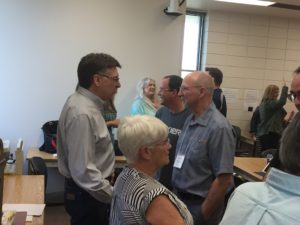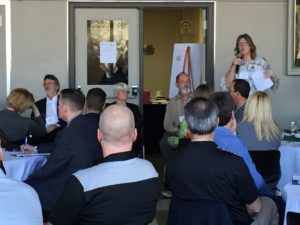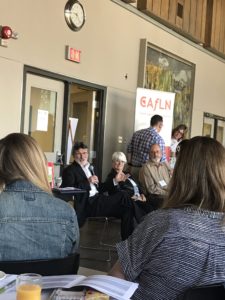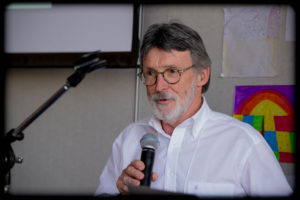The Cycle of Learning : How Formative Assessment Created Beautiful Music
Submitted by: Bruce Mellesmoen
I thought my heart was going to come right out of my chest!
These were the words my 12-year-old son, Bobby, whispered to me. He had just finished playing The Little Drummer Boy for a room full of people he had never met before, and in his words, he “nailed it”. Bobby had been preparing tirelessly for his piano recital, and the hours of practice had paid off with an excellent performance. We both relaxed in our seats and enjoyed the remaining students share their pieces for the Christmas celebration. It was a beautiful way to spend some time with my son, celebrating the learning that had occurred.
I recall how I felt when I learned the title of the piece he would be performing. I was so excited because this was his mother’s favorite Christmas carol, and I knew it would warm her heart to hear her first born play for her. With dogged determination, he practiced over and over, and as the days passed we both began to hear the improvement. I recall the day when he went mistake- free, start to finish, because all he did when he was done was let out a quiet, “Yes!” with a subtle fist pump. He did not stop there; he knew that one perfect performance did not guarantee he would replicate this at his recital. For days I listened to The Little Drummer Boy; sometimes it was perfect, other times there were flaws. What we both noticed was that there were more flawless performances each day. All of that work led up to his performance, a solo that barely lasted one minute from start to finish, including his shy bow before heading back to my side. He did a great job, and I could not have been more proud. As I watched and listened to the kids playing their pieces at the Christmas celebration, I could not help but think about how I was seeing the results of authentic learning in its purest form.

His learning started early.
In our work, we often talk about learning and assessment in terms designed to help us wrap our head around what is considered best practice. We talk about practice time and game day when discussing formative and summative assessments. This was game day for those kids, their guests, and their teachers. The students were given a piece to practice over a period of time, coming back to their teacher on a weekly basis to demonstrate their progress. It was during these lessons that feedback was given to the students and next steps were set up, based on where they were at that moment. The students then went away and practiced some more, continuing the learning cycle.
During this entire learning journey there was not one mark given, only feedback. Some of that feedback occurred in the moment beside the teacher; some of it was in written form in their journal. It was a straight-forward process:
Summative assessment should be a snapshot in time; it should not mean finished and forgotten. Katie White writes, “Summative assessment is the way we verify learning and determine proficiency. It is an essential part of the learning cycle” (p. 153). Note how she says it is part of the cycle, not the end of the cycle. Bobby’s recital was a verification of what he had learned and was an opportunity to show his teacher he is ready for the next challenge. Bobby and I both viewed the recital as his summative assessment, a culmination of his hard work where he had one shot in front of the crowd to demonstrate his proficiency. Of course this does not mean that he is done playing the piano, nor will he stop playing The Little Drummer Boy. He has already talked about how he will be playing this for his relatives this Christmas, and we’ve discussed the possibility of creating a performance tying the songs he knows together in a longer performance.

As the principal of Waldheim School I get to see teachers working with students on a daily basis. It is through the art and science of teaching that our teachers are making this happen. I’ve seen the creative ways teachers are carving out time in the day to listen to students read, to sit beside students as they wrestle with concepts, or to simply stand back and watch them work together to deepen their understanding. I saw a prime example of this while watching students in home economics earlier this year. The students were busy creating fondant for their final project in their cake decorating unit. During this unit I had seen the kids experiment, collaborate, and then seek feedback from their teachers. It was through this formative assessment that the students readied themselves for their final, summative assessment. I really enjoyed watching this unfold, and I also secretly hoped for a slice of cake when they were done!
Assessment is not easy, and when I reflect on how I used to teach, particularly my math classes, I am embarrassed by the steps I failed to take. Here was the normal learning cycle when I taught:
- Tell the kids what they’d be learning (I’d post my objectives by writing, today you will learn…..)
- Have them copy notes off the board
- Demonstrate two or three examples from their upcoming assigned work
- With about 25% of the class time remaining, I’d assign several questions for homework
- Get frustrated the following day when the kids hadn’t figured it out on their own
- Move on with the next lesson because I felt we didn’t have time to stop
- Get more frustrated when the kids failed their tests
- Repeat…
There were so many opportunities for me to do a better job with my teaching, and looking back now I have to pause, understand that I was doing what I thought was best in the moment, forgive myself, and move on.
I wonder how well Bobby would have done had he learned how to play piano the way I taught math. Imagine if he had shown up for lessons only to sit and listen to his teacher play The Little Drummer Boy so he would know how it should sound, but not getting to touch the keys for 75% of the lesson. Imagine the frustration he, my wife, and I would have when he came home to practice, only to have us fail to know how to help him. Imagine him returning for lessons having experienced little or no growth. Now imagine how he would have felt in that church getting ready for his summative assessment. I’m glad Bobby learned how to play The Little Drummer Boy the way he did. I’m glad he ‘nailed it’.
Reference
White, K. (2017). Softening the edges: Assessment practices that honor K – 12 teachers and learners. Bloomington, IN: Solution Tree.
About the Author
Bruce Mellesmoen is the principal of Waldheim School, a K – 12 facility in central Saskatchewan, Canada. Follow him on Twitter @brucemellesmoen
















